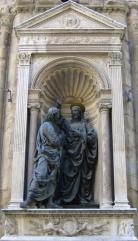Leonardo da Vinci and the Renaissance
Created by Dino Franco Felluga on Sat, 12/29/2018 - 20:24
Part of Group:
This timeline will support a 6-credit study-abroad program for Purdue's Honors College occurring in Paderno del Grappa, Florence and Venice over May 2019. It will be created by the 21 students joining Dino Franco Felluga in Italy for the course.
Timeline
Chronological table
| Date | Event | Created by | Associated Places | |
|---|---|---|---|---|
Uffizi GalleryThe Uffizi Gallery is one of the largest and most important Italian museums, storing a collection of priceless works of art from the Italian Renaissance and beyond. Cosimo de’ Medici commissioned Giorgio Vasari to design the building in 1560. It’s original function was to house Florentine legal and administrative offices, with a private gallery for the collections of the Medici family on the second floor. At the end of the Medici dynasty, The Family Pact of 1737 allowed Anna Maria de’ Medici to declare that the Medici’s art collections may never be moved from Florence, ensuring the permanence of the Uffizi Gallery and its priceless collections. In 1769 the Gallery was opened to the public and has since become one of the most visited museums in the world. “History | The Uffizi.” Uffizi Galleries, www.uffizi.it/en/the-uffizi/history. Image Retrieved from Wikimedia Commons, fair use |
Lauren Krieger | |||
Anatomy Before da VinciGalen was a Greek physician, philosopher, and author that practiced around 150 A.D. He was a well-known physician and served many emperors in the Roman Empire as a personal physician. Galen complied work from original anatomist such as Hippocrates and added his own discoveries and beliefs to write over 20,000 pages of anatomical study. He had a strong belief in experiments and observation, instead of believing what has always been written. This belief helped him make advancements in his career including: Identifying 7 of 12 cranial nerves Proving the kidneys make urine Diagnosing using a patients’ pulse and urine sample Discovering the heart has 4 valves But Galen’s education was still based on old knowledge and he had flaws in his studies such as the belief that an imbalance of humors caused disease and that the liver was the center of the great vessels in the body. Despite this, Galen’s anatomical studies stayed as primary belief for about 1500 years, until scientist like Leonardo da Vinci began to challenge his beliefs. Da Vinci’s artistic ability and engineering studies assisted him in attempting to bring in a new era in anatomical studies, though none of his work was published so little impact was made from all his work. The anatomical revolution was contributed more to Andreas Vesalius.
Sources: Stewart, D. (2014). Galen. Famous Scientist: The Art of Genius. Picture from Wikimedia http://catalogue.wellcomelibrary.org/record=b1165357 |
Christina Hetisimer | |||
X-radiographyX-rays were discovered in 1895 by Wilhelm Conrad Roentgen. Although they are most widely used in the realm of medicine, they also provide a technical method for examining artwork. X-radiography is unique because it is a non-invasive and non-destructive technique that provides information about the construction, structure, and condition of a work. Additionally, it can be used to identify the materials that the object is made from and expose layers of underpainting. This information is important not only for guiding the conservation of an object, but also for attributing it to the correct artist and determining the authenticity of the object. This technique was used to analyze Annunciation and allowed researchers to distinguish the work done by Leonardo da Vinci from the work done by his mentor, Andrea del Verrocchio. The image to the left shows the x-radiograph of Rembrandt van Rijn's The Syndics of the Amsterdam Drapers' Guild, revealing alternate compositions of the group that Rembrandt considered before completing the final painting. “Digital Radiography.” Museum Conservation Institute Imaging Studio, Smithsonian Institute, www.si.edu/MCIImagingStudio/X-ray. History.com Editors. “German Scientist Discovers X-Rays.” History, A&E Television Networks, 24 Nov. 2009, www.history.com/this-day-in-history/german-scientist-discovers-x-rays. Image Retrieved from Wikimedia Commons, fair use |
Lauren Krieger | |||
Childhood ExplorationLeonardo da Vinci grew up in a small Tuscan town in the lower valley of the Arno River, allowing him to explore the many fossil-containing caves at the foothills of the Alps. From a young age, da Vinci questioned the popular Biblical flood theory, instead using logical reasoning accompanied by his own observations to come to the correct conclusion on geological formations hundreds of years before these concepts were popularized. |
Kyra Wilson | |||
Tomb of Piero and Giovanni de Medici by VerrocchioThe tomb of Piero and Giovanni de Medici, completed in 1472, was the Medici’s first major commission from Italian painter and sculptor Andrea del Verrocchio. The sarcophagus is unique both in its composition and its materials. The tomb is set in an archway and uses a combination of coloured marble and porphyry, complimented by decorative bronze ornamentation. Verrocchio was a master of both stone and metalwork, which sets this tomb apart from others of this period. This work is significant not only because it marks the start of the Medici’s lifelong patronage of Verrocchio, but also because it is most likely the inspiration piece for the marble bench that appears in da Vinci’s Annunciation. This provides evidence that Leonardo da Vinci was active in Verrocchio's workshop, and both masters may have had a hand in painting Annunciation Passavant, Günter. “Andrea Del Verrocchio.” Encyclopædia Britannica, Encyclopædia Britannica, Inc., 1 Feb. 2019, www.britannica.com/biography/Andrea-del-Verrocchio. “Tomb of Piero and Giovanni De Medici.” Andrea Del Verrocchio, AndreaDelVerrocchio.com, www.andreadelverrocchio.com/tomb-of-piero-and-giovanni-de-medici/. |
Lauren Krieger | |||
da Vinci's First SketchLeonardo da Vinci’s first known work ("The Hills of Tuscany") is from 1473 when he was 21 years old. The sketch is believed to be inspired by the Arno Valley where da Vinci grew up. Although da Vinci never published his geological theories, his works were geologically correct; he understood the geological processes that shaped our mountains and valleys hundreds of years before the public. |
Kyra Wilson | |||
Milan and "Seashells"From 1482 to 1499, Leonardo da Vinci served as a court artisan to Ludovico Sforza, the Duke of Milan. During his time in Milan, da Vinci was able to not only paint and sculpt but also to study a wide variety of other subjects: nature, flying, mechanics, anatomy, and more. da Vinci reportedly hiked in the nearby Alps and often explored various caves where he studied fossils and rock formations. One day, a group of peasants brought da Vinci (who was known for his interest in rocks) a sack of “seashells” they had found in the mountains, further proof of da Vinci’s developing theories on geology. |
Kyra Wilson | |||
The Virgin of the RocksBetween 1483 and 1486, Leonardo da Vinci painted two copies of “The Virgin of the Rocks.” The painting depicts Madonna, child Jesus, infant John the Baptist, and an angel in a rocky setting reminiscent of the mountains in northeastern Italy. |
Kyra Wilson | |||
Modern GeologyIn 1785, James Hutton, widely seen as the father of modern geology, published his paper Theory of the Earth. In this popular paper, Hutton discusses many of the concepts Leonardo da Vinci had hypothesized hundreds of years earlier. Both men refute the Biblical flood as the foundation for formations we know today and assert Earth must be much older than what was previously believed. |
Kyra Wilson | |||
The fall of the Bronze BallIn 1601, the Florence Duomo lost its bronze ball in a raging thunderstorm. Constructed of nearly two tons of gilded copper and being the highest point in this area of Florence, it was only a matter of time before the sphere was struck by lightning. The sphere did come crashing to the ground, but was quickly rebuilt and restored. The fall of the sphere from the Duomo was shocking and jolting to the people of Florence; in response to this, a white stone has been embedded in the ground in the exact place the ball fell in order to memorialize the engineering feat that was accomplished hundreds of years prior by Verrocchio. Source: The sign of the fall of Verrocchio's golden ball in Forence. (2015, January 07). Retrieved from https://www.guidedflorencetours.com/en/the-sign-of-the-fall-of-verrocchi... |
Marissa White | |||
Da Vinci and Parabolic MirrorsIn a note and sketch dating back to approximately 1515, da Vinci references some of the ideals and machines Brunelleschi invented back when he was constructing the duomo. The sketch and note related to some of da Vinci's work on designing parabolic mirrors and he says, "Remember the solders used for soldering the ball on Santa Maria del Fiore (Florence Duomo)." This artifact exemplifies the inspiration Leonardo drew from Brunelleschi and his machines and further proves Leonardo's involvement with the construction of the duomo. Source: Leonardo da Vinci in Florence: On the Lantern. (n.d.). Retrieved from https://erenow.net/biographies/leonardo-da-vinci-the-flights-of-the-mind... |
Marissa White | |||
"Quarry" by Albrecht DürerLeonardo never published his findings; however, other artists studied his work to enhance the realism of their own geological depictions. One such artist is Albrecht Dürer, nicknamed the German Leonardo for his intellectual curiosity. His “Quarry” was painted after two visits to Italy in which he studied Leonardo’s work. With emphasis on horizontally stratified rocks and vertical joints, da Vinci and Dürer are able to create open, three-dimensional spaces, an increasingly important aspect of Renaissance paintings. |
Kyra Wilson | |||
Milan Cathedral DesignIn 1487, officials in Milan asked architects to submit design ideas for a tiburio, lantern tower, for the top of their under-construction cathedral. Leornardo collaborated with architects Donato Bramante and Francesco di Giorgio on the design. He worked to design a double-shell dome, very similar to the one in Florence's cathedral. However, Leonardo favored a more traditional style, so he did not try to make his dome match the gothic design of the rest of the Milan cathedral. As a result, his designs were rejected and he eventually withdrew his application. The winning designs came from Francesco di Giorgio, and architect from Siena, who Leonardo worked with on other projects later on. Source: Isaacson, Walter. “Vitruvian Man”. Leonardo Da Vinci. Simon & Schuster, 2017 Photo Source: http://www.leonardo-da-vinci.net/architecture/ |
Allison Skadberg | |||
The death of BrunelleschiOn April 15, 1446, Filippo Brunelleschi, the overseer of the reconstruction of the Florence Duomo, died. His architecture and the machinery he designed to make it possible made a lasting impact not only on Florentine architecture, but inspired Leonardo's love and interest in machinery, physics, and engineering. The death of Brunelleschi also meant that someone else had to be hired to create and place the lantern, bronze ball, and cross at the top of the duomo. Verrocchio was hired for the job, meaning that Leonardo was able to work even closer on the duomo as he was an apprentice of Verrocchio. Source: Mueller, T., & Yoder, D. (2017, September 19). Brunelleschi's Dome. Retrieved from https://www.nationalgeographic.com/magazine/2014/02/Il-Duomo/ |
Marissa White | |||
Completion of Santa Maria del FioreConstruction of the Santa Maria del Fiore cathedral, also known as il Duomo, was completed in the year 1436. From start to finish, the cathedral took over 140 years to complete. Though Leonardo had no influence on the dome, as it was designed and constructed before he was born, the dome had a great impact on him. Da Vinci loved to incorportate domes into his architectural designs, as they require a combination of mathematical and artistic influences. Sources: http://www.leonardo-da-vinci.net/architecture/ https://theculturetrip.com/europe/italy/articles/16-interesting-facts-about-florence-cathedral/ Photo Source: https://theculturetrip.com/europe/italy/articles/16-interesting-facts-about-florence-cathedral/ |
Allison Skadberg | |||
Duke of Milan Hires da VinciIn 1482, Leonardo left Florence to enter the service of Ludovico Sforza, the Duke of Milan. Under Sforza, Leonardo painted, sculpted, and made designs for machinery, weapons, & buildings. He also did several studies on geometry, construction, canals, and architecture, designing "everything from churches to fortresses." Though he did some traveling and advising on other projects during this time, Leonardo lived in Milan and worked for the Duke until his fall from power in 1499. Source: https://buffaloah.com/a/virtual/italy/milan/sforza/leo.html |
Allison Skadberg | |||
Discovery of Anatomy through ArtLeonardo da Vinci showed a great artistic ability at a young age. Da Vinci’s father, Piero Fruosino di Antonio da Vinci, took note of his son’s skill and when da Vinci turned 15 years old, sent him to apprentice renowned artist Andrea del Verrocchio. It was here that da Vinci began his anatomical studies. Verrocchio had a studio in Florence where he taught many artist in addition to da Vinci. As part of the apprenticeship, Verrocchio made all of this students study anatomy to assist them in depicted human bodies realistically, which was popular during the Renaissance. Da Vinci studied structure, function, and proportions of the body, using his sharp eye to depict startingly life-like sketches. But da Vinci took his work studying human form and took it many steps further. Da Vinci’s curiosity lead him to more research looking at the functions of body systems. He performed several dissections to study the internal body. Da Vinci sketched countless drawings and wrote pages and pages of notes. These sketches and notes could have on his research that could have changed the subject of anatomy had they have been published.
Sources: Gunter, P. (2006) Andrea del Verrochio: Encyclopedia Britannica. Heydenreich, L.H. (2019) Leonardo da Vinci: Anatomical Studies and Drawings. Encyclopedia Britannica. |
Christina Hetisimer | |||
Annunciation by Leonardo Da VinciAnnunciation is generally considered to be one of Leonardo’s earliest works, created during his time as an apprentice in the studio of Andrea del Verrocchio. Dating from around 1472, this painting, made with tempera and oil on a wood panel, depicts one of the most popular subjects for artwork throughout this period. The left side of the composition is dominated by the archangel Gabriel who is seen kneeling and holding a bundle of white lilies, the symbol of the virgin. Opposite of Gabriel, Mary is seen acknowledging the arrival of the angel from behind a marble bench, where she was reading. The event is set in an earthly, natural environment, with landscape painting in the background that is characteristic of da Vinci’s later works. “Annunciation.” Artworks, Uffizi Galleries, www.uffizi.it/en/artworks/annunciation. Image Retrieved from Wikimedia Commons, fair use |
Lauren Krieger | |||
Andrea del VerrocchioAndrea del Verrocchio was a 15th century Italian sculptor, painter and goldsmith. Very little biographical information is known about the early life of Verrocchio, but it is thought that he studied painting with Sandro Botticelli under the Renaissance master Fra Filippo Lippi. He was also trained as a goldsmith, and in fact took the name "Verrocchio" from his master. Verrocchio’s rise to artistic prominence is largely owed to the patronage of the Medici family, who supported his career as a sculptor. His reputation across the country led many great artists to study in his studio, perhaps most importantly young Leonardo da Vinci. Passavant, Günter. “Andrea Del Verrocchio.” Encyclopædia Britannica, Encyclopædia Britannica, Inc., 1 Feb. 2019, www.britannica.com/biography/Andrea-del-Verrocchio. Image Retrieved from Wikimedia Commons, fair use |
Lauren Krieger | |||
Da Vinci's Fetal StudiesLeonardo da Vinci wrote detailed works on embryotic and fetal studies, using the anatomical information he gained while working with physician Marcantonio della Torre in 1506-1511. Da Vinci was the first to correctly draw the fetus positioned in a single chambered womb. Ingeniously, da Vinci did so without having access to a fetal or female cadaver. He used his cow dissection to reconstruct a human in the womb. This is why the uterus is a sphere instead of a more pear-like shape. He was also first to correctly draw the uterine artery and other corresponding vasculature. Prior da Vinci’s representation, it was thought the uterus had multiple chambers. But through his studies, da Vinci proved them wrong. Da Vinci’s fetus in the womb picture was revolutionary both anatomically and artistically. Johnathon Jones, an art critic, declared da Vinci’s work as “…the most beautiful work of art in the world.” In addition to his pictures, da Vinci also was the first to describe the three fetal membranes and nodded to how the “maternal and feto-placental vasculatures did not communicate (Dunn, 1997).” These notes show how da Vinci almost anticipated the discovery of human and fetal circulation which was not discovered fully until the 1600s by William Harvey.
Sources: Dunn, P.M. (1997). Leonardo da Vinci (1452-1519) and Reproductive Anatomy. Archives of Disease in Childhood- Fetal and Neonatal. 77(3). Isaacson, W. (2017). Leonardo da Vinci. New York: Simon and Schuster |
Christina Hetisimer | |||
| circa. -399 to circa. -350 |
The Flexible Bow CatapultWith the specificity of ancient Greek tactical warfare as a quest to conquer cities of breadth, depth, and optimized defense, the rulers of Greek colonies during the fourth century B.C. era became increasingly interested in improving their range and decimating force of weaponry in their lustrous goals to secure any and all sieges or battles. Thus, the commencement for designing a weapon to redefine infringing warfare began in 399 B.C. when Dionysius the Elder, the Greek ruler of the colony of Syracuse in Sicily, issued a declaration to produce new novel weapons, one of which was the infamous catapult. Although categorized as the first catapult recorded through conventional documentation, these ancient catapults more closely resembled the common draw-bows of soldiers during this era and utilized what has now been coined, “The Flexible Bow Mechanism,” an apparatus which generates power through tension created by movable sliders. Thus, these mechanical bows were responsible for launching arrows through the compositionally conglomerative use of composite wooden ores, tension fibers of animal sinew, and wooden compression horns. Contrary to the depiction of stereotyped catapults, one should note that this initial design remained attached to the human subject as, descriptively, this preliminary design was to be worn across the shoulders of soldiers on the battlefield and strategically placed along a surface once one’s destination was secured. However, records also suggest that the soldiers of Syracuse were also known to have constructed mobile siege towers that were to overlook enemy city walls and utilize flexible-bow catapult to provide heavy aerial fire. The design also received notable adjustments in its inception. This included the preferred use of animal sinew to human or horsehair for optimized elastic tension, the addition of linear ratchets alongside the weapon’s main stock which increased the resistive force of the bow, and the use of a circular rachet to allow winches to be used in the drawing of the highly compressed bow. Furthermore, the weapon’s highly optimized precision was said to have made the catapult an attractive device for the ruling Greek commissioners. Thus, due to the increased precision of the bow, the size of the design quickly increased to favor more impactful assaults. While no longer permitting the mobility of the device by mere human strength, the catapult required a lower pedestal for stability purposes. To facilitate this change in design, the ancient engineers of Syracuse were recorded as the creators of the first iteration of the universal joint, a mechanism which is commonly thought to originate in the 16th and 17th century by either Girolamo Cardano or Robert Hooke. While there is not any official recording for the approximate range of these early catapults, these weapons were said to have been able to utilize arrows nearly two meters long and decimate enemy forces with deadly accuracy. Sources: History of Catapults - Physics of Catapults. (n.d.). Retrieved May 6, 2019, from https://sites.google.com/site/physicsofcatapults/home/history-of-catapults Yurtoğlu, N. (2018). Http://www.historystudies.net/dergi//birinci-dunya-savasinda-bir-asayis-sorunu-.... History Studies International Journal of History, 10(7), 241-264. doi:10.9737/hist.2018.658
|
Benjamin Koszyk | ||
| circa. -350 to circa. 500 |
The Torsion CatapultTransitioning from the Flexible Bow catapult 50 years prior, the increasing interest in the utility of the catapult lead to the subsidization of the next phase of this devastating weapon, the Torsion Catapult. Commissioned by Philip of Macedon, the father of Alexander the Great, around 350 B.C., the newly developed catapult utilized what is referred to as the torsion principle, a system which requires tightly wound fibers being drawn to a notched pull. This specific catapult apparatus significantly improved the range and precision of the previous catapult design and was largely unchanged for many centuries. With slight adjustments deriving from physicists and engineers such as Philo of Byzantium, Archimedes of Syracuse, Hero of Alexandria, and Vitruvius of Rome, the torsion catapult was able to transition from launching arrows the size of light javelins and handheld stones to projectiles weighing as much as 78 kilograms. Moreover, according to Vitruvius, these catapults, when unloaded, were capable of weighing 162 kilograms and most commonly launched projectiles ranging from 13 to 26 kilograms at a range of 640 meters. With their high degree of intrinsic accuracy and wall-penetrating power, historical commanders ranging from Alexander the Great to Julius Caesar were known for utilizing these weapons in significant historical battles such as the siege of Gaza in 332 B.C., the Roman siege of Syracuse from 213 to 211 B.C., and the siege of Jerusalem in 63 B.C.
With the advent of this creative weapon, shifts in politics and society arose. Firstly, the increased mechanization of warfare displaced the human-to-human contact and denounced the personability of war as one’s emotional investment in eliciting physical violence was replaced by strategic aerial assault tactics. This increased separation of battling forces was noted by Philo of Byzantium in 200 B.C. as he claimed, in his artillery manual, that a wall had to be at least 4.62 meters thick to withstand catapult stones and that the minimum distance to maintain between the walls of a defensive fortress and a catapult should be at least 150 meters. Thus, by noting that a wall-reducing device was now readily available in warfare, new social constructs had to be developed in order to preserve social living space. For example, Aristotle, in the mid-4th century B.C. was quoted in suggesting that the newly popularized quadrilateral city blocks of ancient civilizations be combined with the prior, ancient landscapes, such as motes, inner-city defense walls, and ditches, in order to maintain structural composition of these newly developing cities when subjected to the decimating force of invading catapults. Conversely, the introduction of the torsion catapult also significantly redefined the Eurasian political landscape as Alexander the Great’s successfully dominating conquest was considerably assisted by his use of this optimized weapon. With the development of the catapult proving to be an imperative military marvel, the equality of arms in warfare was lost and the technical skills necessary to operate mechanical weapons foreshadowed the first differentiations of status amongst military operations. Moreover, the specialized knowledge in mathematical and technical skills required to construct and maintain catapults thus increased the social status of catapult engineers as military experts and allowed them to survive political purges. Sources: International Symposium on History of Machines and Mechanisms : Proceedings of HMM 2008, edited by Hong-Sen Yan, and Marco Ceccarelli, Springer, 2009. ProQuest Ebook Central, http://ebookcentral.proquest.com/lib/purdue/detail.action?docID=417096. Created from purdue on 2019-05-09 18:07:26. Yurtoğlu, N. (2018). Http://www.historystudies.net/dergi//birinci-dunya-savasinda-bir-asayis-sorunu-.... History Studies International Journal of History, 10(7), 241-264. doi:10.9737/hist.2018.658 |
Benjamin Koszyk | ||
| circa. -350 |
Ctesibius’ Catapult and The Repeating CatapultWith the domination of the catapult now solidified in the social and pollical hierarchies of ancient civilizations, efforts to further improve the catapult were attempted. Beginning with Ctesibius of Alexandria in mid-3rd century B.C., this ancient engineer was credited with an attempt to use airtight cylinders and compress bronze springs to pivot rigid firing arms to a point of optimized tension. However, with the compression of air and the introduction of piston friction, unexpected fire and smoke emitted from the catapult’s cylinder were responsible for decreasing both the structural rigidity, as the carpenter’s glue used to construct the device was heated, and range of Ctesibius’ catapult. Furthermore, simultaneous development also begun on what is referred to as the “Repeating Catapult” by Dionysius of Alexandria in an arsenal in Rhodes. The repeating catapult, an invention which employed mechanisms not reintroduced until the Renaissance, was a theoretically and idealized model with the intention to automatically fire arrows until a revolving drum containing ammunition was emptied. Essentially proposing a model for an ancient machine gun, this catapult was most notable for its inclusion of a flat-linked chain drive system which was to be later popularized and accredited to Leonardo da Vinci during the early 1500s. This flat-link chain drive, resembling that used on a modern bicycle chain, was to run over a five-sided prism and repeatedly turn a winch to release and draw the main stock of the weapon. Regarding da Vinci’s later involvement with the chain-drive device, this chain drive mechanism precisely embodies what he idolized as the fundamental relationship between an object’s mass and velocity while investigating the basic laws of perpetual motion. Ultimately, this design was never developed due to its paradoxical ability to only fire concentrated shots at a minuscule range of 200 meters that could not be dispersed away from one central target before running out of ammunition. Sources: Rossi, C., & Russo, F. (2010). A reconstruction of the Greek–Roman repeating catapult. Mechanism and Machine Theory, 45(1), 36-45. doi:10.1016/j.mechmachtheory.2009.07.011 Yurtoğlu, N. (2018). Http://www.historystudies.net/dergi//birinci-dunya-savasinda-bir-asayis-sorunu-.... History Studies International Journal of History, 10(7), 241-264. doi:10.9737/hist.2018.658 |
Benjamin Koszyk | ||
| circa. -300 to circa. 1500 |
The Onager Mangonel CatapultDeveloped presumably during the early Roman era from what many believe to be 300 to 400 B.C., the manganon, or the “engine of war,” is what many believe constitutes today’s classification of an ancient catapult. Consisting of a singular launch and block arm, this machine was designed to be pulled to a desired pitch angle from its naturally perpendicular orientation relative to the ground in order to be released to fire a loaded projectile under the properties of torque and angular acceleration. The desired launch angle of the projectile could also be adjusted by placing the block arm horizontally closer or farther from the launch arm when placed at its maximum downward position. Moreover, the mangonel was said to have the capabilities of firing projectiles distances of over 1,000 feet (with a maximum of 1,300 feet), and required less mechanical knowledge to develop, maintain, and operate. According to the ancient Roman historian, Ammianus Marcellinus, these devices were also said to yield significantly greater forces of impact than the previously employed bow and torsion-based catapults. Additionally, according to the ancient Romans, the power and motion of the mangonel catapult mimicked the ferocity of an “onagoras” or “a wild ass,” eventually solidifying the catapult’s full name as the catapult containing the ferocity of wild animals. Sources: History of Catapults - Physics of Catapults. (n.d.). Retrieved May 6, 2019, from https://sites.google.com/site/physicsofcatapults/home/history-of-catapults Yurtoğlu, N. (2018). Http://www.historystudies.net/dergi//birinci-dunya-savasinda-bir-asayis-sorunu-.... History Studies International Journal of History, 10(7), 241-264. doi:10.9737/hist.2018.658 |
Benjamin Koszyk | ||
| circa. -100 to circa. -60 |
Antikythera MechanismThis is the first ever recorded use of clockwork, and dates back to Ancient Greece, It is speculated to have been used to predict astronomical events such as eclipses, or perhaps to track the 4-year cycle of ancient olympic games. After detailed imaging, it is suggested that the original mechanism contained 37 gears to follow the sun and the moon, to predict eclipses, |
Eric Liu | ||
| circa. 1 to circa. 1 |
Euclid's Elements (300 BC)With its five postulates and thirteen books, Euclid’s Elements (written circa 300 BCE) set the precedent for the way humans do mathematics, establishing a norm of clearly stated assumptions and carefully delineated logic when giving a proof. As such, Elements was the seminal text for geometry in the plane well until the nineteenth century when new geometric paradigms supplanted Euclidean geometry. The revived interest in the intellectual achievements of the Greeks during the Renaissance certainly included a fascination with Euclidean geometry, which provided the mathematical underpinnings for Renaissance painters to develop perspective, a technique used to represent a three-dimensional image on a flat surface. While perspective was an important feature in da Vinci’s paintings, it was also a crucial aspect in his geometric sketches in which he was tasked with finding the best way to depict complicated three-dimensional geometric figures in the plane. Lastly, Elements established a norm of codifying mathematical knowledge into a single text, a norm that Luca Pacioli (the geometer for whom da Vinci created geometric sketches) strived to uphold with his comprehensive mathematical summaries such as De Divina Proportione and Summa de arithmetica, geometria, proportioni et proportionalita (the first of which necessitated da Vinci’s artistic abilities for illustrations). Sources Kline, Morris. “Projective Geometry.” Scientific American, vol. 192, no. 1, 1955, pp. 80–86., doi:10.1038/scientificamerican0155-80. “Luca Pacioli.” Luca Pacioli (1445-1517), School of Mathematics and Statistics, University of St. Andrews, Scotland, www-history.mcs.st-and.ac.uk/Biographies/Pacioli.html. Shearer, Rhonda Roland. “Chaos Theory and Fractal Geometry: Their Potential Impact on the Future of Art.” Leonardo, vol. 25, no. 2, 1992, pp. 143–152., doi:10.2307/1575702. The image source is Wikimedia Commons, and it is in the public domain in the United States because it was published (or registered with the U.S. Copyright Office) before January 1, 1924. |
Garrett Mulcahy | ||
| 1 |
Archytas Creates the Flying PigeonArchytas, a Greek philosopher who lived between 428 BC and 347 BC, is believed to be one of the first people to investigate the idea of flight. He created a steam-powered flying pigeon sometime during his lifetime; however, the exact timing of this invention is unknown. The naming of this device came from the fact that it resembled the shape of a pigeon: wings on either side and a pointed front like a beak. The pigeon contained an opening at its rear which was connected to a heated boiler. The steam produced by the heated water caused an increase in pressure that produced the force required to eject the pigeon, which was reported to fly for several hundred meters. Source (text and image): Reese, M. R. (2014). The steam-powered pigeon of Archytas—the flying machine of antiquity. Ancient Origins. Retreived from https://www.ancient-origins.net/ancient-technology/steam-powered-pigeon-archytas-flying-machine-antiquity-002179. |
Ali Jeffries | ||
| circa. 1 |
Early Civilizations Introduce Concept of Structural ReciprocityStructural reciprocity is a design concept in which different load-bearing elements in a design support each other along the length of the element, allowing for an even distribution of weight across the structure rather than strictly at the ends. Early civilizations demonstrated knowledge of this concept through their homes, even if they had not formally named it yet. For instance, Neolithic civilizations constructed pit dwellings built of structurally reciprocal elements as early as 10,000 to 4,500 BCE. Additionally, Eskimo tents and and teepees constructed by Native Americans also used structural reciprocity in their design. During the reign of Julius Caesar, this concept was translated to infrastructure through the construction of a bridge that spanned the Rhine River composed of interlocking wood. The ancient Chinese also used structural reciprocity by weaving baskets with interwoven bamboo strips and constructing interwoven circular roofs in Buddhist temples. Sources: Pugnale, A., & Sassone, M. (2014). Structural Reciprocity: Critical Overview and Promising Research/Design Issues. Nexus Network Journal, 16(1), 9-35. Retrieved May 16, 2019, from https://link.springer.com/article/10.1007/s00004-014-0174-z [Portrait of Gauis Iulius Caesar. Marble, augustan age, Roma, Musei Vaticani, Museo Pio Clementino, Galleria dei Busti]. (n.d.). Retrieved May 16, 2019, from https://commons.wikimedia.org/wiki/File:Gaius_Iulius_Caesar_Vatican.jpeg The image, taken from Wikimedia Commons, is in the public domain. |
Katherine Li | ||
| 2 |
The Geocentric ModelAncient Greek Philosophers such as Aristotle, Plato, and others, porposed the geocentric model of the universe, claiming that the Earth was the center of the universe and all the planets and the stars revolved around us in concentric circles. This theory was then ammended by Ptolemy to account for the changes in certain planet's luminosity. He determined that, rather than the planets and the sun simply be orbiting around the Earth, they would simultaneously be moved by a system of two spheres creating a second path of circular motion (shown in the below link). This explaination was widly accepted for over a thousand years, including the time da Vinci lived. |
Corinne Evans | ||
| circa. 30 |
Vitruvius publishes "De Architectura" (30 BC)Between 30-20 BC, Vitruvius publishes "De Architectura", a book that serves as a foundation for architecture, engineering, and town planning. Vitruvius also elaborates on proportionality in the human body and relates it to the construction of a pleasing temple structure. In these passages, Vitruvius's descriptions of human proportions would inspire Leonardo da Vinci to draw his "Vitruvian Man". Source: Isaacson, Walter. “Vitruvian Man”. Leonardo Da Vinci. Simon & Schuster, 2017. Photo Source: https://commons.wikimedia.org/wiki/File:De_architectura_libri_dece_Wellc... |
Alexa Lahey | ||
| circa. 30 to circa. 30 |
The Baptism of JesusAlong the River Jordan in Palestine, Jesus was baptized by St. John the Baptist. Baptism is the first Christian Sacrament and is the pouring of water over one’s head. Baptism cleanses the receivers of their sins, including Original sin, and the welcomes them into the Christian Church. The Baptism of Jesus is the first Baptism mentioned in the Bible, thus instilling the sacrament, and giving Christian’s an example that is still followed today. Jesus' Baptism is also the first time the Trinity (The Father, The Son and The Holy Spirit) is seen all together in the Bible. All three persons of God were present at the Baptism, showcasing the significance of the event. As Jesus was baptized the heavens opened up, a dove (the Holy Spirit) came down and rested on Jesus, and the Father's voice was heard from the Heavens. Source: https://www.compellingtruth.org/Jesus-baptized.html Image retrieved from WikiMedia Commons: https://commons.wikimedia.org/wiki/File:Baptism_of_Christ_Baptistery_Florence_copy.jpg |
Cara McCormick | ||
| circa. 1 Apr 33 |
The Last SupperThe subject matter of Leonardo da Vinci’s Last Supper is a major event recorded in the Bible during the life of Jesus Christ - the last meal that Jesus had with his disciples prior to his arrest and crucifixion, where he predicts aloud that one of his disciples will betray him. The after effects and shock from this statement is the moment that is portrayed in da Vinci’s painting. The biblical Last Supper also begins the tradition of the Eucharist, the ritual of consuming bread and wine as Jesus’ body and blood, which still occurs during Christian Mass every Sunday. There is debate about the specific date on which the Last Supper occurred, but new research points to April of AD 33, and the traditional location in which it would have taken place is Mount Zion, in Jerusalem. As the event of the Last Supper is so important to Christianity, it was painted over and over throughout multiple different art paradigms, as even well into the Renaissance the vast majority of art depicted religious events. With such a popular topic, it only makes sense for da Vinci to have painted it as well. Sources: McKenny, L. (April 17, 2011). New theory on date of Last Supper. Retrieved from https://www.smh.com.au/world/new-theory-on-date-of-last-supper-20110416-... Lipnick, J. (September 7, 2016). Where Did Jesus Eat The Last Supper? Retrieved from https://blog.israelbiblicalstudies.com/holy-land-studies/where-did-jesus... |
Leila Yanni | ||
| circa. 80 |
The Birth of Vitruvius (80 BC)Vitruvius was born around 80 BC. He was a famous military engineer and architect. While most of his life is undocumented (including exactly where he lived), it is known that was alive while Italy was under the rule of the Roman Empire. He is most known for his theories about proportions in temples and the human body, including the first recorded measurements that would inspire da Vinci to sketch his Vitruvian Man. Source: Isaacson, Walter. “Vitruvian Man”. Leonardo Da Vinci. Simon & Schuster, 2017. Photo Source: https://www.thefamouspeople.com/profiles/vitruvius-34320.php |
Alexa Lahey | ||
| circa. 1200 to circa. 1299 |
The Quomodo Organistrum Construatur is WrittenThe earliest clear influence in the playing mechanism of the viola organista does not necessarily come from bowed instruments themselves. Rather, the hurdy-gurdy is a more concrete example of the method of sound generation that da Vinci was searching for. The hurdy-gurdy is an instrument similar to a violin, with a hand crank to vibrate the strings and keys to signify specific notes. While the instrument was depicted in various forms throughout the 12th century, the first manuscript detailing how to divide the tuning into a diatonic scale was released in the 13th century, titled the Quomodo Organistrum Construatur. The author of this piece is debated, as the person it is often attributed to, Odo of Cluny, died centuries before the volume was completed. Separate instruments including various combinations of wheel-cranks and keys were combined and refined in this document. These instruments were likely used for newly written polyphonic music in Catholic monasteries, including ones in Italy. One string was typically designated for drones, allowing for much easier creation of polyphonic parts, as the player did not need to actively play the string separately because of the unified hand-crank. Severini, G. (2018, December 17). Organistrum / Symphonia keyboard in Santiago de Compostela cathedral. Retrieved from https://liuteriaseverini.it/index.php?Itemid=1014&id=42:inquiry-into-a-t... Hurdy-gurdy (Medieval). (n.d.). Retrieved May 14, 2019, from https://caslabs.case.edu/medren/medieval-instruments/hurdy-gurdy-medieval/ Hurdy-Gurdy [Digital image]. (2005, February 17). Retrieved from https://pl.wikipedia.org/wiki/Plik:Hurdy-Gurdy.jpg |
Christopher Embry | ||
| circa. 1280 to circa. 1280 |
Verge and Foliet ClockThe Verge and Foliet are the first escapements to be used to construct the first mechanical clocks. Using a notched wheel and a rod wih two plates, the rotational motion of the wheel can be controlled and regulated into small ticks. These escapements were used in all clocks until the pendulum was introduced, and da Vinci used these mechanisms in his own clockwork. |
Eric Liu | ||
| 1296 |
The Construction of the Duomo beginsIn 1296 the Florence Duomo began construction. Florentines desired a symbol to showcase the power and status of their city, and at this time there was no better way to do that than to create one of the largest and most immaculate cathedrals in the world. The duomo at its beginning had a Florentine Gothic style, until its reconstruction under Brunelleschi, when it transformed to more of a Renaissance style. Source: Leonardo da Vinci in Florence: On the Lantern. (n.d.). Retrieved from https://erenow.net/biographies/leonardo-da-vinci-the-flights-of-the-mind... |
Marissa White | ||
| circa. 1400 to circa. 1400 |
Oil Paint as a MediumUp until the 15th century, the most common medium for painting was tempura paint. Tempura paint dries very quickly, meaning artist using tempura could not easily blend colors. Tempura paintings have been found from about 3000 BC. on early Egyptian sarcophagi decorations, thus showing how long tempura had been the most common medium. This shows monumental the transition from tempura to oil paint truly was. Oil paint began to make its way to Europe in the 12th century but was not widely adopted until the 15th century. The appeal to oil paint was that it dried slowly which allowed artist to continually work the paint. This allowed for artist to blend the paints thus allowing for softened transitions between colors, and results in a more accurate depiction of shading. The technique spread to Italy in the late 1400's starting in Venice and by 1540 oil painting completely dominated as the most popular medium - tempura was no longer being used at all. Oil paints often only came in a few premade colors, there artists had to mix small amounts of colors to create more shades, often done on a wooden palette. The crescent shaped wooden palette that is typically a symbol of an art, is in reference to oil painters. Sources: https://en.wikipedia.org/wiki/Tempera https://en.wikipedia.org/wiki/Oil_paint https://en.wikipedia.org/wiki/Oil_painting Image retrieved from Wikimedia Commons: https://commons.wikimedia.org/wiki/File:Cadmium-paints-amy-lavine.jpg
|
Cara McCormick | ||
| 1418 |
Brunelleschi is Hired to Build the DomeIn 1418, Brunelleschi is hired to build the dome. The former cathedral ceiling was worn down and leaked often. Brunelleschi's vison for a dome top was a new concept and was not at first embraced because of the engineering challenges it engages. Eventually, however, his plan went through and he was able to begin construction on the dome. |
Marissa White | ||
| 1425 to 1454 |
Wars in Lombardy:The wars in Lombardy were a series of struggles between the Republic of Venice and the Duchy of Milan, leading to the five major Italian territorial powers that make up the map of Italy until the Italian Wars (i.e., Venice, Milan, Florence, Naples, and the Papacy). The wars ravaged the economy of Lombardy and weakened the power of Venice. The Peace of Lodi in 1454 brought 40 years of comparative peace to Northern Italy. This is the time of the Medici rule of Florence, first Cosimo de’ Medici, then Piero “the Gouty,” then Lorenzo Il Magnifico. The death of Lorenzo marked the end of the Golden Age of Renaissance Florence. Both Leonardo da Vinci and Michelangelo Buonarroti were active (and tied to Lorenzo) during this period. In 1428, Venice acquired Brescia and Bergamo as a result of this struggle. |
Dino Franco Felluga | ||
| 15 Apr 1452 |
Leonardo da VinciLeonardo da Vinci was born April 15, 1452 in Vinci, Italy. As a child he did not have any special formal education, but when he was a teenager his father recognized his artistic talent and arranged for him to be trained under the famous artist Andrea del Verrochio from Florence. From this apprenticeship he was introduced to many technical skills such as metal working, as well as improving his painting and sculpting techniques. Since he was a scientist, artist, and inventor among many other things, his knowledge of many disciplines gave him the title of a Renaissance Man. His most famous paintings are the Mona Lisa and The Last Supper, and he is also recognized for his study of human anatomy and his many inventions. He died at 67 in the year 1519. Image source: Wikimedia commons, listed as public domain in the United States because it is a photographic reproduction of a public domain work of art. |
Juliana Ilmain | ||
| 29 May 1453 |
The Fall of ConstantinopleThe fall of Constantinople marked the end of the Byzantine Empire after ten centuries of war. The Ottoman Turks defeated felled the city and ended the European Middle Ages. The Byzantine Empire had been a bastion of Christian Europe facing Muslim Asia. The Ottoman Turks were expanding their empire and saw Constantinople as a center of the rival Christian faith and a symbol of imperial power. Constantinople had held off many attempts to destroy or capture it but was declining in power over the years. Mehmed II set out to take the city in the spring of 1453 and used the sea to gain access to the city. Initial attacks failed, but on May 29th, Mehmed launched attacks from the sea and the land simultaneously. The Ottomans were finally able to overwhelm the defenses due to the use of gunpowder-powered cannons. After gaining access past the walls, the Ottomans killed the emperor and massacred the citizens. Mehmed rode a white horse down streets that ran with blood to Hagia Sophia, the city's famed cathedral. He used the cathedral as a mosque to say prayers of thanks for the victory. The fall of Constantinople was important because it was a watershed moment in military history. The city had defended itself with walls and ramparts since ancient times. These fortifications were used as the model of many later cities. The end of the Byzantine Empire marks the end of the Medieval period. Bunting, Tony. “Fall of Constantinople.” Encyclopædia Britannica, Encyclopædia Britannica, Inc., 22 May 2018, www.britannica.com/event/Fall-of-Constantinople-1453. “Fall of Constantinople.” Wikipedia, Wikimedia Foundation, 2 May 2019, en.wikipedia.org/wiki/Fall_of_Constantinople. |
Lindsay Rubin | ||
| 9 Apr 1454 |
The Treaty of LodiThe Treaty of Lodi was the peace agreement between Milan, Naples, and Florence. It was signed in Lodi, Lombardy by Milan, Venice, and Florence. It ended the Wars in Lombardy. The treaty established boundaries between Milanese and Venetian territories in northern Italy. The balance of power was established and excluded the smaller states. A second agreement was signed August 30th in Venice. The purpose of this agreement was establishing principles of non-aggression. The Treaty of Lodi was significant because it brought Milan and Naples into a definitive peace alliance with Florence. The treaty provided a new state system model and institutionalized a regional balance of power built on diplomacy. However, the balance of power was disrupted in 1494 with the start of the Italian Wars. “Treaty of Lodi.” Wikipedia, Wikimedia Foundation, 24 Sept. 2018, en.wikipedia.org/wiki/Treaty_of_Lodi. |
Lindsay Rubin | ||
| 1460 |
Paolo Uccello's The Hunt in the ForestPaolo Uccello was an Italian painter who died just before the Renaissance. In one of his last paintings titled The Hunt in the Forest, we can see perspective beginning to appear in art. Uccello's piece also is a great example of how plants and trees were painted during the pre-Renaissance. His plants show variation and stand out from each other, but they still don't look like a real tree. Uccello's plants in the foreground also still maintain the symbolic look rather than the realistic look that would appear during the Renaissance. Image from Wikimedia Commons, commons.wikimedia.org/wiki/File:Paolo_Uccello_The_Hunt_in_the_Forest.jpg. This image is under common domain and free use. |
Kayla Cole | ||
| 1469 |
Lorenzo de MediciLorenzo de Medici, the grandson of Cosimo de Medici, came to power in 1469. Lorenzo is thought of as the most powerful patron of the Medici family and is remembered as the greatest patron in the history of Italy. Some of the talent Lorenzo sponsored as a patron includes Michelangelo Buonarroti and Leonardo da Vinci, two of the most famous people in history. Under Lorenzo's rule, Florence earned its reputation as the most beautiful city in Europe. Additionally, the economy of Florence prospered like never before. |
Mara Kossoff | ||
| circa. 1472 to circa. 1475 |
Verrocchio and DaVinci paint 'The Baptism of Christ'"The Baptism of Christ" was commissioned to Verrochio by the monks of San Salvi, a church located in Florence. It is thought that the painting was worked on by Verrocchio, DaVinci, and possibly one other older artist. At the time it was very common for artist to paint the main figure and leave the secondary figures to their pupils. It is thought an older artist may have painted the dove and the hands for the appear to be less developed than the rest of the painting. DaVinci is known to have painted the left angel in the painting as well as Jesus' figure and parts of the background. In the background it can be seen that DaVinci began to play with sunlight, mist and shadows giving the painting three-dimensional feel, while the parts of the background Verrocchio did, such as the trees, have more of a static feel. DaVinci used oil paint for his parts of the painting. Oil paints allowed DaVinci to create smoother transitions and gradients between his colors, creating a more realistic look. These smooth transitions can be seen in the shadows and shading of Verrocchio’s parts of the painting, such as the hair of the angel and the shading of Jesus’s body. Something unique DaVinci did was give his angel’s face emotion as well as have the angel be paying attention to the main event of the painting. At the time is was not common for secondary figures to display either of these things. Most secondary figures were depicted like Verrocchio’s angel, staring off bored into the distance. This is just another aspect displaying how ahead of his time DaVinci truly was. Source: https://www.leonardodavinci.net/the-baptism-of-christ.jsp image was found on Wikimedia https://commons.wikimedia.org/wiki/File:Baptism_of_Christ_by_Andrea_del_Verrocchio.jpg |
Cara McCormick | ||
| 5 Aug 1473 to 5 Aug 1473 |
The First Work: "La Valle dell'Arno"The first of his drawings, Da Vinci sketched "La Valle dell'Arno" when he was 21. It is one of the first pieces to show a landscape without any religious symbols or human. With the Renaissance occurring at this time, it only goes to show how daring Da Vinci was in terms of separating the church from the artistic and scientific aspects of life. Instead, viewers see an approximately to scale scene of the Arno Valley and without any elements beings completely distorted to show how God may see the world. This was an essential development as maps at this time were influenced by artists' views and Da Vinci showed that not everything needed to have a relation to God or the church. Additionally, it encouraged the idea that scale can be shown in an image with human viewers in mind, thus there should be a direct relationship between the actual landscape and that drawn. Source: “Landscape Drawing for Santa Maria Della Neve - by Leonardo Da Vinci.” Leonardodavinci.net, www.leonardodavinci.net/landscape-drawing-for-santa-maria-della-neve.jsp. |
Chloe Romero | ||
| circa. 1475 |
Cesare Borgia is bornCesare Borgia is born around 1475. Leonardo da Vinci would later be a patron of Borgia from 1502 to 1503. Mallett, Michael Edward. “Cesare Borgia.” Encyclopædia Britannica, Encyclopædia Britannica, Inc., 28 Mar. 2019, www.britannica.com/biography/Cesare-Borgia-duke-of-Valentinois. |
Ben Hardin | ||
| 1475 to 1475 |
Verrocchio gives up the brushIn recent times, X-rays have been done on the painting 'The Baptism of Christ' that reveal a completely different outline for the angel that DaVinci painted. This indicates DaVinci followed his own vision rather than his master's from very early on in his career (he was only in his early 20's at this time). Often times people say Davinci's angel stands out from the rest of the painting for it is significantly better, as it is far more realistic and detailed. After seeing DaVinci's detailed and far superior angel in their painting "The Baptism of Christ", Verrocchio became embarrassed and ashamed that his pupil was a better artist than him. It is said that after realizing this he vowed, out of shame, to give up painting for the rest of his life. This rang true, as "The Baptism of Christ" is Verrocchio's last known painting. He continued work as an artist but focused on drawing and sculptures. After this time Verrocchio completed some of his best works such as "The Doubting Thomas" located outside the OrsanMichele in Florence or the "Equestrian statue of Bartolomeo Colleoni" in Venice, Italy. Sources: http://www.leonardo-da-vinci.net/baptism-of-christ/ Image was found on Wikipedia https://upload.wikimedia.org/wikipedia/commons/b/b2/Christ_with_St._Thomas_the_Apostle_of_India.jpg
|
Cara McCormick | ||
| circa. 1478 to circa. 1519 |
Leonardo da Vinci Incorporates Structural Reciprocity in Other DesignsLeonardo da Vinci demonstrated a thorough understanding of structural reciprocity not just through his arched bridge design, but also through his design of complex geometric structures that could form domes or roofs. He was one of the first scientists in the West to propose complex architectural designs composed of reciprocal structures that extended into three dimensional space. This was revolutionary for the time, as much of Western architecture was predicated upon hierarchical, rather than reciprocal, logic. In the Codex Atlanticus, da Vinci proposed a series of six designs of interconnected, reciprocal geometric shapes. Though the exact date of these designs is not identified, they most likely informed or went hand-in-hand with da Vinci’s work on the arched bridge. Both indicate that da Vinci was thinking about space in innovative ways that no engineers or architects had done before. Sources: Pugnale, A., & Sassone, M. (2014). Structural Reciprocity: Critical Overview and Promising Research/Design Issues. Nexus Network Journal, 16(1), 9-35. Retrieved May 16, 2019, from https://link.springer.com/article/10.1007/s00004-014-0174-z Taddei, M. (2006). [Unique edition of the Codex Atlanticus as a box. Made by Mario Taddei in the 2007]. Retrieved May 16, 2019, from https://commons.wikimedia.org/wiki/File:Mario_Taddei_Unique_edition_of_the_Codex_Atlanticus_-_Codice_Atlantico-www.mariotaddei.net_(27b).jpg Photo, taken from Wikimedia Commons, is free to use under the Creative Commons Attribution-Share Alike 4.0 License. |
Katherine Li | ||
| 1479 to 1482 |
Da Vinci contributes to Colleoni monument in Verrocchio's workshopLeonardo Da Vinci heavily contributed to Verrocchio's Colleoni equestrian statue monument from both an artistic and structural engineering standpoint. Artistically, his anatomical studies of horses and his notebook entries of the horse's frame by frame movements impacted the Colleoni monument design (Kulenovic and von Platen). In particular, his sketches of the horse's suspended leg and warrior's face are reflected in the monument design. His engineering principles relating to structural stability of the horse with only three ground points are seen through his splitting of the horse into two parts, his idea of removing the inner structure and casting each individual piece into bronze, and the running of a tension bean through the two parts of the horse from the tail to the front of the harness to hold it together (Kulenovic and von Platen). By saving bronze, he saved money and decreased the weight of the horse, which improved stability. The Colleoni monument served as one of the first representations of Da Vinci's ability to combine art and engineering principles. Sources: Kulenovic, R., & Von Platen, F. (n.d.). Questions Concerning the Equestrian Statue in Remembrance of the Condottiere Bartolemeo Colleoni in Venice Created in the Workshop of Andrea Del Verrocchio. Retrieved from http://www.museumldv.com/venice.htm |
Juliana Sarisky |


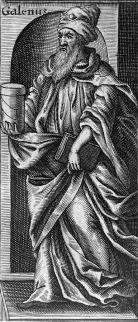

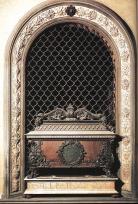


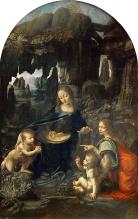
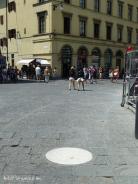
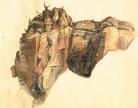
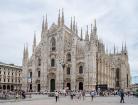
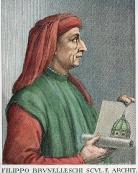


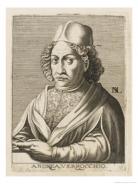
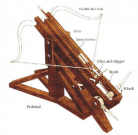
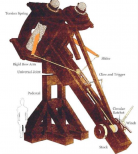



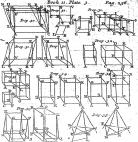

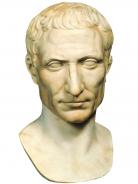
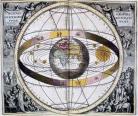
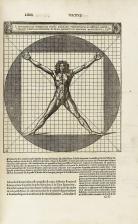
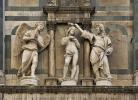
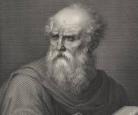
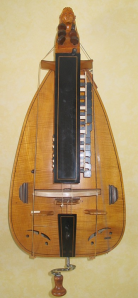
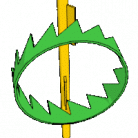


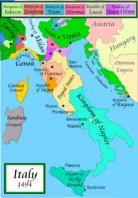
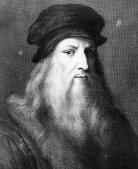

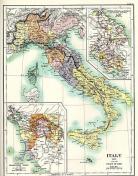

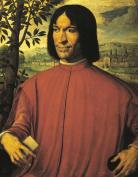
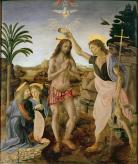
![La Valle Dell'Arno https://www.leonardodavinci.net/landscape-drawing-for-santa-maria-della-neve.jsp#prettyPhoto[image1]/0/](https://editions.covecollective.org/sites/default/files/styles/front_thumbnail/public/chronology-uploads/Valley%20Arno_0.jpg?itok=QrKKdOUf)
